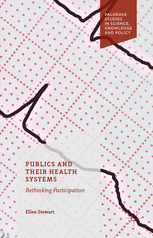Book Review: Publics and Their Health Systems: Rethinking Participation by Ellen Stewart
Drawing on a detailed case study of Scotland’s National Health Service, Publics and Their Health Systems: Rethinking Participation is a novel contribution to the growing academic engagement with the institutionalisation of public participation as a routine feature of governance. Author Ellen Stewart offers a ‘citizen’s-eye view’ of the Scottish health system, challenging dominant policy narratives by exploring diverse forms of public participation around one system. Helen Pallett praises this rich empirical account, which will be vital for future theorising of public participation and for scholarly interventions into broader systems.
Publics and Their Health Systems: Rethinking Participation. Ellen Stewart. Palgrave Macmillan. 2016.
 Once viewed as a radical challenge to mainstream politics, public participation has in many contexts become a routine feature of governance. Over the last two decades, public participation processes have become institutionalised in the domains of development, planning, science policy-making, scientific research, healthcare and more. In Publics and Their Health Systems: Rethinking Participation, Ellen Stewart joins a growing community of scholars from different academic fields in recognising that it is now often difficult to find instances of policy- or decision-making where no public participation has taken place. She seeks to engage critically with the ways in which this institutionalisation of participation is transforming governance.
Once viewed as a radical challenge to mainstream politics, public participation has in many contexts become a routine feature of governance. Over the last two decades, public participation processes have become institutionalised in the domains of development, planning, science policy-making, scientific research, healthcare and more. In Publics and Their Health Systems: Rethinking Participation, Ellen Stewart joins a growing community of scholars from different academic fields in recognising that it is now often difficult to find instances of policy- or decision-making where no public participation has taken place. She seeks to engage critically with the ways in which this institutionalisation of participation is transforming governance.
Stewart’s approach to this challenge is a novel one. Rather than focusing on individual instances of participation around her chosen topic of healthcare in Scotland – as is the conventional approach in the participation literature – she explores multiple forms of participation in and around the Scottish health system. In doing this, she offers not only what she refers to as a ‘citizen’s-eye view’ of the Scottish health system – challenging the framing of dominant policy and academic narratives – but also describes a system of participation which shapes who gets to participate, how they participate and what issues they can participate about.
Various accounts of deliberative systems, systems of practice and constitutional relations shaping participation have been advanced in recent years, but Stewart’s book is the first monograph to map such a diversity of different forms of participation around one system. The book is organised around five contrasting modes of participation in the health system, and Stewart draws on her own empirical work to shed light on the differences between these modes of participation and their relationships to each other and to the Scottish health system. Stewart considers participation through lay membership of committees concerned with health governance, one-off events or outreach work – ‘the quintessential terrain of participation’ (55) – the inclusion of elected representatives on Health Boards, protests against hospital closures and the simultaneously mundane and subversive engagement of everyday users of Scotland’s NHS.

Credit: David Holt CC BY-SA 2.0
This detailed account demonstrates how these different forms of participation are produced alongside different visions of, or roles for, the public. For example, Stewart describes how lay committee members are carefully selected for their particular skills and experience. They are then expected to adopt the standard procedures of these governing bodies just like the other members. In contrast, protesters against hospital closures took a much more active and explicitly political role, though they were often presented by policy-makers and academics as being dangerously partisan and irrational, undermining the legitimacy of their participation in the system. While everyday service users are often assumed to be passive recipients of healthcare services, Stewart’s interviews with a group of young people show the very active but often unacknowledged ways in which they participated in their own treatment: for example, by gaming appointment booking procedures or negotiating their own diagnoses. These roles stray from the demographically representative public or the ‘ordinary’ unknowledgeable public that is usually assumed in policy and academic accounts of health service participation.
Though the definition of the issues at stake in participation processes is not at the centre of Stewart’s argument, her examples illustrate how divergent definitions of the health issues under discussion and the health system being participated in are produced through these different practices. For example, Stewart found that the practice of committee work was characterised by a focus on the procedures and governance of healthcare, often foreclosing discussions of controversial issues. Even the experiments in including elected representatives on Health Boards were unable to alter these tacit practices, with representatives who had campaigned on specific political issues such as disability rights or hospital closures either resigning their positions or adopting conventional bureaucratic practices. In the case of outreach events around healthcare, Stewart offers a brilliantly worked through example of how the narrow framing and interpretation of a particular outreach event worked to reinforce existing policy logics around the topic of pregnancy support, even where participants had contributed a wide range of different perspectives.
The most important contribution of Stewart’s combination of carefully contextualised descriptions and wide-ranging comparisons is perhaps the significant challenge it offers to conventional assumptions about participation in both policy and academic work. She shows that accounts of participation which only consider the temporary participation processes created through outreach work, and even those which also consider citizen involvement in health committees, give only a very partial picture of participation in the Scottish health system. To only consider these ‘invited’ forms of participation ignores the multiple other ways in which citizens participate, the different roles they inhabit and the different views of the health system and health issues that they articulate.
Stewart’s account also begins to hint at the connections and overflows between these different kinds of participation: for example, where governance committees are involved in outreach work or encounter protesters, where the issues considered too controversial to discuss in committees overspill into broader public debate or where marginalised groups who refuse to participate in committees or outreach processes still participate in shaping the health system and their own health care in quietly subversive ways.
This book is an excellent illustration of the value of mapping a particular system, quickly uncovering both its diversity and exclusions. As Stewart acknowledges, there is more to be done to explore and problematise this system in order to systematically identify instances and forms of participation, and to consider how they interact with and shape the Scottish health system. Stewart argues in her conclusion that her account shows the important role played by academics themselves in inscribing and shaping participation around health, demonstrating the scope for future work exploring citizens’ participation in the health system through their involvement in research projects. There are also multiple forms of everyday participation and engagement with health and the health system which could be explored in this way.
This monograph demonstrates the value of the recent turn to whole systems or institutional studies of public participation. Rich empirical accounts such as this one will be vital to further theorising and attempts to intervene in these broader systems.
—
Note:this post represents the views of the author and not those of Democratic Audit or the UK. Please read our comments policy before posting. It originally appeared on the LSE Review of Books.
—
Helen Pallett is a lecturer in the human geography of the environment in the School of Environmental Sciences at the University of East Anglia. Her research is concerned with the intersections between science policy processes and practices of democracy. Her past research includes in-depth ethnographic work into institutionalised practices of public engagement in UK science policy, and she is currently working on a UK Energy Research Centre-funded project which involves mapping diverse forms of public participation around the UK energy system and carrying out new participation experiments. Helen tweets at @HelenPallett and you can find out more about her research here.





 Democratic Audit's core funding is provided by the Joseph Rowntree Charitable Trust. Additional funding is provided by the London School of Economics.
Democratic Audit's core funding is provided by the Joseph Rowntree Charitable Trust. Additional funding is provided by the London School of Economics.
Book Review: Publics and Their Health Systems: Rethinking Participation by Ellen Stewart https://t.co/r3XCPGnBVO
Book Review: Publics and Their Health Systems: Rethinking Participation by Ellen Stewart https://t.co/43WEybZGqZ
Book Review: Publics and Their Health Systems: Rethinking Participation by Ellen Stewart https://t.co/ZeBmfadm7k
Book Review: Publics and Their Health Systems: Rethinking Participation by Ellen Stewart https://t.co/2ij2g6m0WM https://t.co/xiqiDWewou